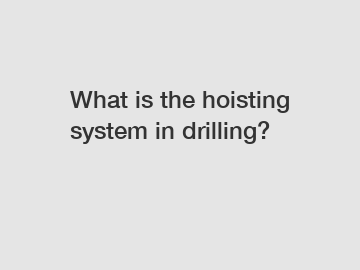What is the hoisting system in drilling?
When it comes to drilling operations, one of the most crucial systems in place is the hoisting system. This system is responsible for lifting and lowering the drill string, casing, and other tools in and out of the wellbore. Without a properly functioning hoisting system, drilling operations would come to a halt, making it a key component in the success of any drilling project.
The hoisting system consists of several components that work together to ensure the smooth and efficient movement of materials in and out of the wellbore. The main components of the hoisting system include the drawworks, the crown block, the traveling block, and the drilling line.
The drawworks is essentially the heart of the hoisting system, providing the power needed to raise and lower the drill string. It is typically powered by an electric or diesel engine and is controlled by the driller from the rig floor. The drawworks also houses the braking system, which is essential for controlling the speed at which materials are lifted and lowered.

The crown block is a stationary pulley located at the very top of the derrick. It is used to redirect the drilling line coming from the drawworks down to the traveling block, which moves up and down the derrick and is responsible for supporting the weight of the drill string. The drilling line is a heavy-duty cable made of steel that connects the drawworks to the traveling block and is what actually lifts and lowers the drill string.
So, how does the hoisting system work in practice? When drilling operations begin, the drawworks is engaged to start lifting the drill string out of the wellbore. The drilling line is spooled out from the drawworks, through the crown block, and down to the traveling block. As the traveling block moves up, it raises the drill string out of the wellbore. Once the desired depth is reached, the drawworks is engaged in the opposite direction to lower the drill string back into the wellbore.
While the hoisting system may seem straightforward, there are several factors that must be considered to ensure its safe and efficient operation. For example, the weight of the drill string, the depth of the well, and the speed at which materials are being lifted and lowered all play a role in determining the optimal settings for the hoisting system. Additionally, proper maintenance and inspection of the hoisting system components are essential to prevent any potential safety hazards or equipment failures.
In conclusion, the hoisting system is a critical component of any drilling operation. Without a properly functioning hoisting system, drilling operations would be impossible. By understanding how the hoisting system works and the various components involved, drillers can ensure the safety and efficiency of their operations. Proper maintenance and inspection of the hoisting system are key to preventing any potential issues that could lead to costly downtime or safety hazards. With a well-maintained hoisting system in place, drilling operations can proceed smoothly and successfully, leading to successful completion of the project.
If you are looking for more details, kindly visit land oil drilling rig supplier, desilter in drilling rig, solids control equipment manufacturer.
171
0
0

Comments
All Comments (0)